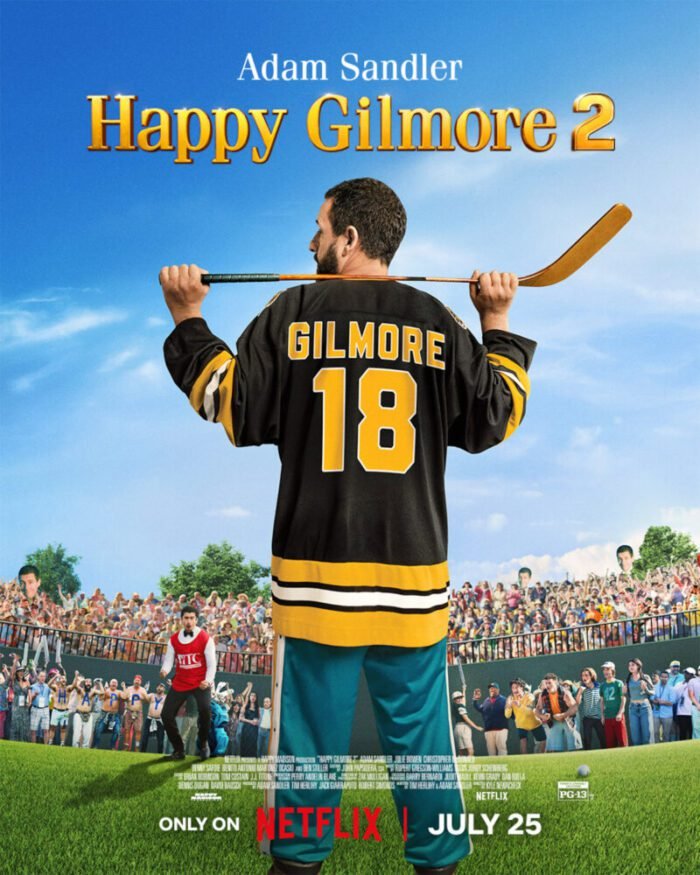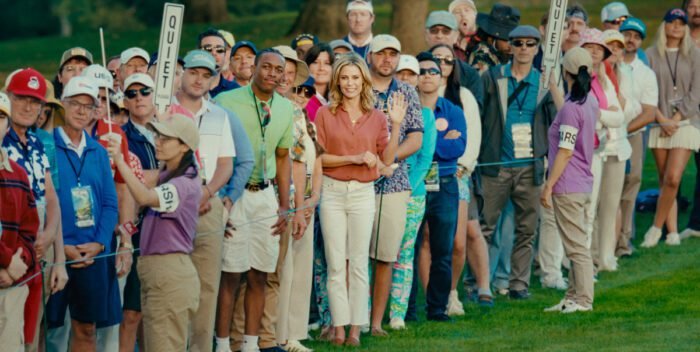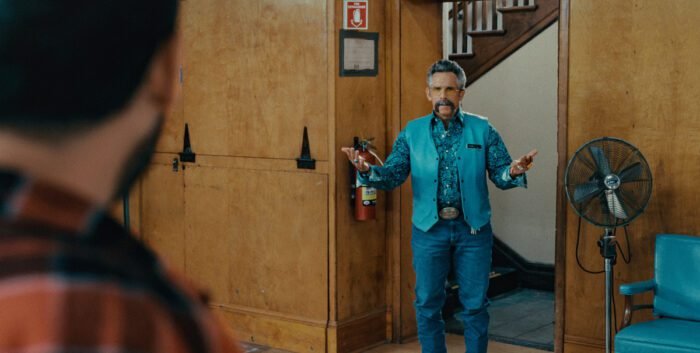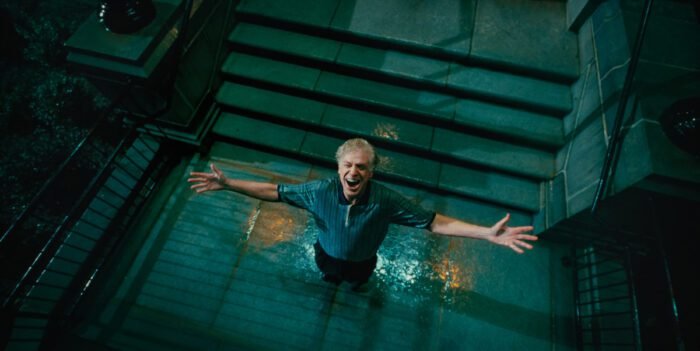When a sequel to a movie comes along thirty years later, it’s hard to know what to expect. Ever since the first teaser earlier this year that showed Shooter McGavin (Christopher MacDonald) standing in his pajamas in a cemetery reuniting with his arch-rival Happy Gilmore, I think a lot of fans of the twenty-nine-year-old comedy had a lot of hopes for what an irreverent golf sequel to the original would look like. Being a child of the nineties, Happy Gilmore was a VHS tape synonymous with family vacations, alongside The Great Outdoors, The Naked Gun, and What About Bob? Comedies my family laughed through dozens of times over the years. So when a film is so well-revered, perfectly encapsulated in a single story, there can be worry that a sequel could topple the love for its predecessor.

To understand my trepidation with unnecessary sequels, you should look no further than the flinching cringe of Dumb and Dumber To. I hadn’t seen the film when it was released back in 2014 after reviews and audiences had unkind words to say, but I finally got a look earlier this year when my family came for a visit. Sure, there were some serviceable bits for the forty-year-olds who remember the original’s release, but the writers messed with the characters’ backstories. Instead of allowing the absurdity to grow with the characters, they took it to new levels of stupidity that made the entire room wish we’d never put it on.
Nevertheless, I grabbed my remote and a can of beer, hoping for the best with Happy Gilmore 2.
When we last left Happy, he was on top of the world. He’d won his first gold jacket by beating out Shooter McGavin, earned the love of Virginia Venit (Julie Bowen), and paid off his grandmother’s debts to reclaim her house. But no one stays at the top for long, and happily ever afters rarely last. After amassing five gold jackets and five kids, Gilmore is considering retirement, wanting to settle down and watch his kids grow up with his wife. She convinces him to keep going, ultimately setting the stage for the catalyst of this sequel. A powerfully hit golf ball ricochets off a tree, killing Virginia. Happy ends his career, loses his grandmother’s house, and turns to the bottle, living out his days working in a supermarket, hoping to never pick up a golf club again.
In terms of lighthearted comedic fare, Happy Gilmore 2 begins with stark realism, a far cry from Dennis Dugan’s boisterous romp. Even though the first film starts with a whirlwind of bad things happening around Happy, the struggles in the sequel genuinely raise the stakes. I suppose that’s life, though, considering the added responsibilities Happy would have thirty years later.

Happy’s daughter Charlotte (Sandler’s real-life daughter Sadie Sandler) has dreams of dance school, and even her brothers (Maxwell Friedman, Phillip Schnider, Ethan Cutosky, Conor Sherry) agree that her talent shouldn’t be contained to their small urban home’s porch. So Happy tries to get his groove back (it’s all in the hips!!) despite a contention to the game, drinking his way through a warm-up round with a group of millennials. However, his drinking lands him in a court-ordered support group led by the familiar face of his grandmother’s nasty orderly, Hal L. (Ben Stiller), who does his best to make Happy miserable.
In the midst of Happy’s return to the game, a new villain emerges. Frank Manatee (Benny Safdie) bears a striking resemblance to a millennial version of Stiller’s Dodgeball character, White Goodman, particularly in his extreme sports drink persona and team of enhanced mega-golfers. When Happy turns down Manatee’s offer to join his golfing league, it’s solely based on Manatee’s shitbag personality. Safdie does a great job as the ultra-hateable, frosted-tip infused douchebag who thinks he’s better than everyone else and brings a sense of indignance and entitlement to the role to make the audience seethe with repulsion whenever he’s on screen. And, like someone you’d want to punch, decides to pull strings to try to shmooze Happy’s nemesis, Shooter McGavin, in an “enemy of my enemy” move.
McGavin, who has lived in an institution since losing to Happy Gilmore in the first film’s finale, is released with the hopes of messing with Happy. However, for as onboard as you think McGavin would be to join Manatee and get revenge on his thirty-year rivalry, Manatee’s methods don’t appeal to McGavin and call into question the integrity of the sport. This all leads to a Space Jam-style tournament between the PGA’s best and Manatee’s crew.

Happy Gilmore 2 is one of the more befuddling movies I’ve seen in recent memory. Tonally, it’s all over the map. There’s a lot of somber, grief-filled poignancy that becomes offset by silliness and toes the line of dark comedy. The film’s first half is oddly magnetic, working unexpectedly by balancing the absurdity of life and all its disappointments. When Happy arrives home to see his daughter dancing on the porch, you’re moved by the grace of the camera pan and Sandler’s will to support the family who’ve supported him through their heartbreak… Then you’re suddenly laughing, discovering professional golfer John Daly has taken up residence in the Gilmores’ garage.
Cameos abound in Happy Gilmore 2, from the few I’ve already mentioned to names like The Substance’s Margaret Qualley, pop sensation Bad Bunny (in a hilarious turn), The Sixth Sense’s Haley Joel Osment, Breaking Bad’s Lavell Crawford, Eric Andre, Steve Buschemi, Travis Kelce, and so many more. Like every Sandler vehicle, Happy Gilmore 2 is loaded to the rafters with friends and family, from the usual suspects to a whole host of new ones.
While I never really banked on using the words “loaded with subtext” when describing Happy Gilmore 2 of all films, director Kyle Newacheck’s film is absolutely stuffed. Written by Sandler and his long-time collaborator, going back to his SNL days, Tim Herlihy, Happy Gilmore 2 has a lot to do with being analog in a digital world, one where cheating has become permitted in games, specifically video games, though watching the rules of baseball change, including those “torpedo bats” the Yankees are using, feels like part of the conversation here as well.

While there is a quick cut of watching Happy Gilmore 2’s diegetic take on the Tiger Woods golf game franchise devolve into Mortal Kombat, the film tees up this idea that practice isn’t necessary if you can afford to enter at a high competitive level. Throughout the film, we watch Happy struggle and practice to stage his comeback. We also watch his daughter practice her dancing. Meanwhile, Manatees’ competitors arrive at the tee with no dues paid, yet play on an elite level. This commentary explores microtransactions in competitive video games, hints at AI involvement in filmmaking, and ties it to the use of performance enhancements in traditional sports. Pretty heady for an Adam Sandler sequel film about a buffoon who can hit a golf ball, eh?
There’s an argument here for not taking the easy route in many contexts. Whether it’s turning to the bottle or learning a skill, these methods don’t benefit humanity. Someone can say they wrote an article or film script with AI tools, but isn’t that cheating? They didn’t actually write it, and they’re taking credit for using a learning model that exploits real writers’ voices. Isn’t evolving a part of life’s journey? Even Happy and Shooter find common ground, which isn’t easy for two adversaries. The frustrating struggle and overcoming weakness is a part of that, and that’s why we feel proud when we create or accomplish something. It’s strange that Happy Gilmore 2, of all films, would be the kind of nuanced comedy that stands up for passion and tradition, especially since Netflix just used generative AI for an FX shot in the new series, El Eternauta, which also released this week.
This could be Happy Gilmore 2’s South Park moment in a way, standing up to its streaming giant and arguing for more human involvement. South Park returned this week with an exceptionally divisive episode featuring President Trump and regarding free speech, as a kind of rebellion against their new streaming home. Paramount paid $1.5 billion for the exclusive streaming rights to South Park just after cancelling Stephen Colbert’s The Late Show, the nation’s number one late-night talk show, citing financial reasons. However, many have implied the cancellation is a bad look for the company, as it may have been the crux of a deal with the President to silence Colbert so he would approve Skydance’s merger with the flailing media company. While Happy Gilmore 2 doesn’t go this far to speak truth to power, it does go against Netflix’s plans to utilize AI more openly in its future programming.
Happy Gilmore 2 is funny, though it is a bit uneven overall. Unlike a film like Dumb and Dumber To, Happy Gilmore’s sequel is surprising, different, and slightly grown-up, even if there are plenty of sophomoric jokes to help us feel young again. The film manages to pay tribute and do fan service to the original, and there are plenty of laugh-out-loud gags. Some will find it difficult to grasp tonally, as it’s unlike its breezy predecessor in many ways. Regardless, Happy Gilmore 2 was far better than I expected, carrying a lot of heart and supplying absurd laughs as Sandler gets the crew back together.
If you’re looking to continue down the “golf titles with heart” rabbit hole, I would recommend AppleTV+’s Owen Wilson dramady Stick, which does feel inspired from a few things in the Happy Gilmore playbook. Stick’s season finale coincides with Happy Gilmore 2’s release, and it’s a great bingeable show to follow up the film with.
Happy Gilmore 2 is now streaming on Netflix.

